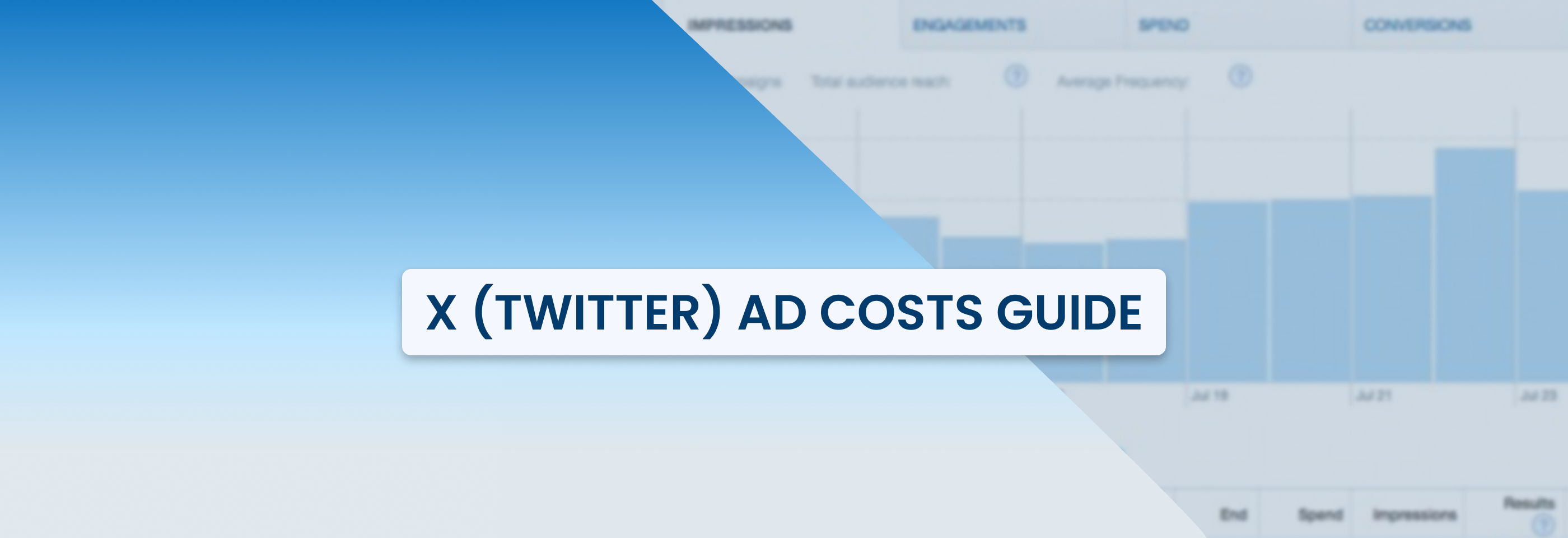Facebook Ads Budget: Set Up the Right Budget for Facebook Ads
2022-05-18
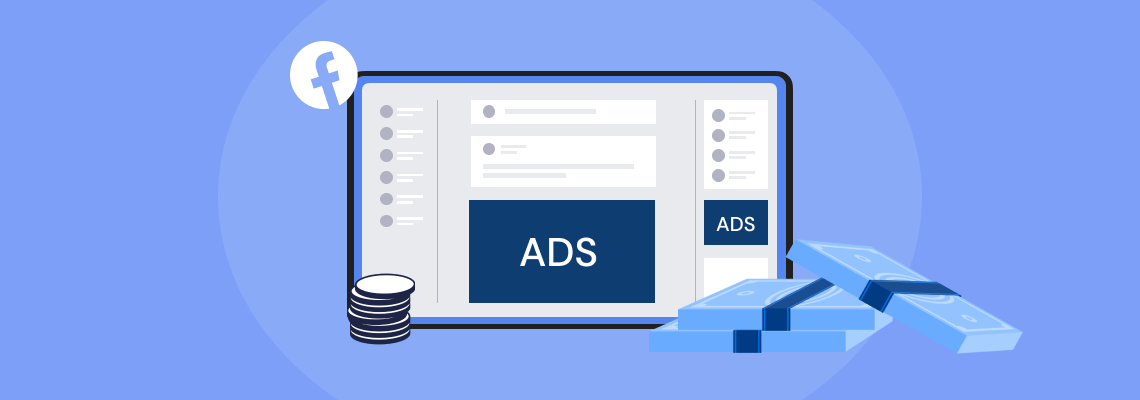
How Facebook charges for ads
Let us begin with the definition in order to shed some light on the way facebook charges for ads. A budget is the amount of money you choose to spend on reaching out to individuals with your ads. Simply put, budget is the amount you are willing to spend on running your ad.
When you run ads on Facebook, you establish a budget for ads that you run. You'll only be charged for the number of clicks or impressions your ad generated when and you will not be charged more than the amount you specified in your budget. Also, note that the budget you set isn't always the same as the actual amount of money you spend.
In addition, ads budget may also serve as a cost-cutting solution. In the same way that a bid strategy helps you manage your cost per result, it helps you control your overall spend for a campaign or ad set.
The way you set budget will be defined by how much control you want to give the Facebook algorithm when it comes to ad optimization. As you set up your ad campaign in Facebook Ads Manager, you’ll be able to set specific parameters for your ads at the campaign and ad set level. We’ll look through some of the most important of them.
Types of Facebook Ad Budgets
There are two types of Facebook budgets, each with its own set of advantages and disadvantages. Choosing the incorrect one might have a negative impact on the success of your campaign. We'll go through each of them in depth below.
But first, it’s needed to figure out what type of budget suits you the most. It’s necessary to get an idea of how much of your overall Facebook ad budget is allocated to each ad set. There are two main options: setting a campaign budget or setting individual ad set budgets. Let’s dig into it.
Campaign budgets vs Ad set budgets
The budget can be set at one of the following levels:
Campaign budgets: All campaign budgets use campaign budget optimization (CBO). With a campaign budget, Facebook decides how to spend money effectively on your behalf instead of giving each ad set the same amount of money. It is an excellent setup choice for marketers who are new to Facebook ads.
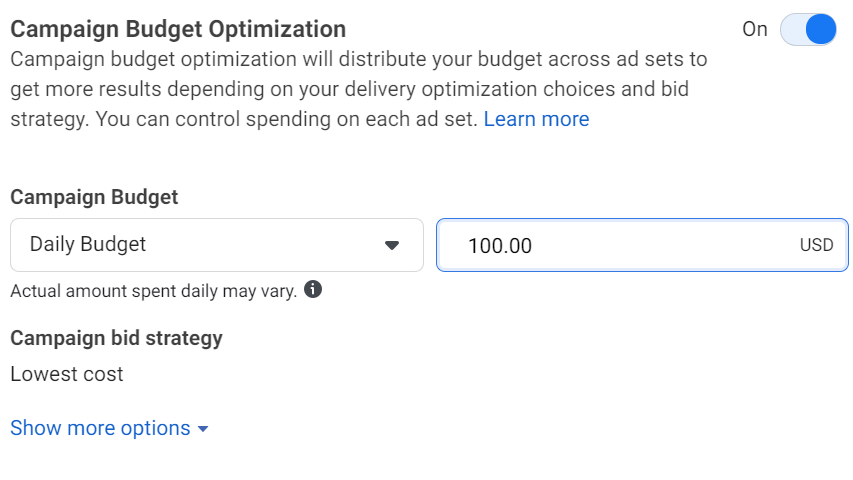
How it works: You establish a single central budget for all of your ad sets and allow a Facebook algorithm to distribute your money across ad sets to achieve the best outcome. The algorithm identifies which ad sets have the highest chances of providing you with the greatest return on investment and delivers more money to them.
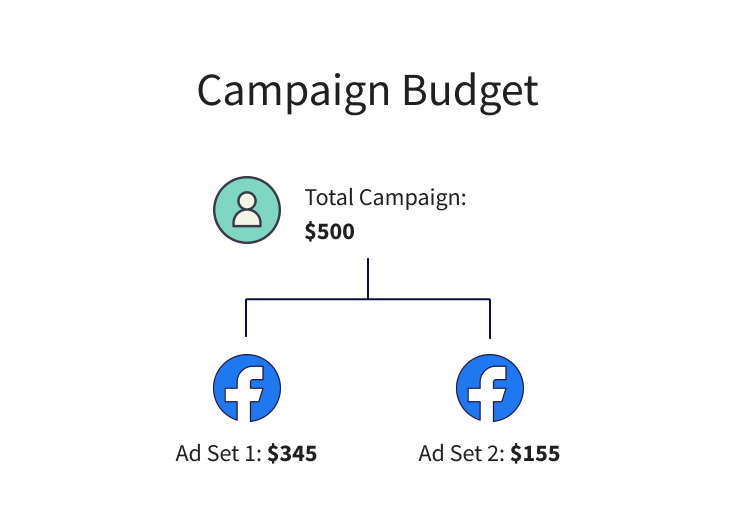
Advantages of campaign budget optimization:
- can simplify campaign setup
- reduces the number of ad sets you have to manage manually
- helps to get the most out of the campaign for the least amount of money
- allows managing campaigns with lots of ad sets
- a good choice if you’re flexible with how your budget is spent across ad sets
Drawbacks of budget optimization:
- the algorithm may underestimate ad sets that will possibly provide future value (for instance, those that are narrowly targeted at a small but important new market)
Ad set budgets: An ad set budget gives marketers the ability to control how much money goes to each ad set. This is a good option for experienced marketing specialists who have an experience with ad campaigns and have the ability to manage and evaluate variable ad set metrics.
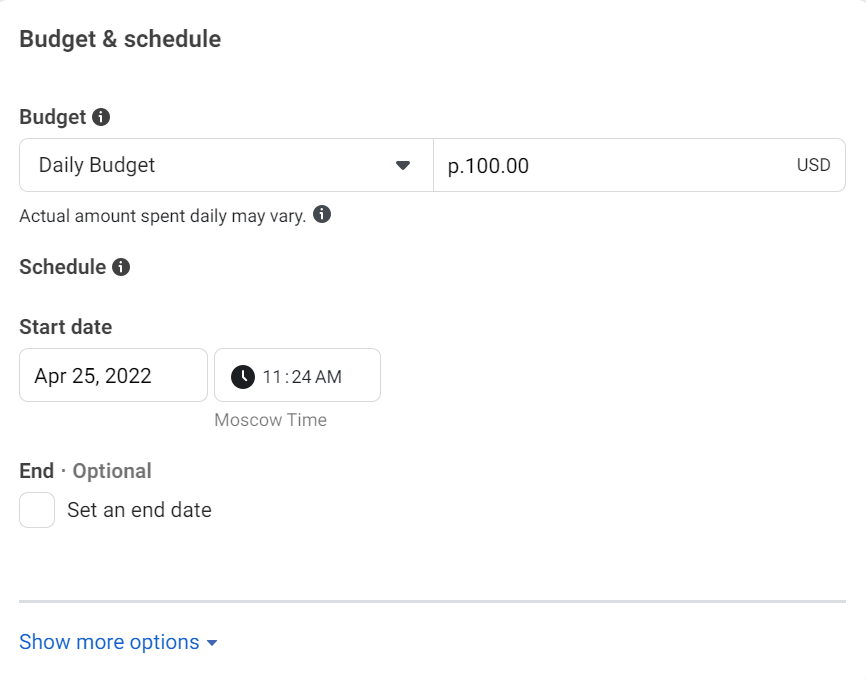
How it works: When you set the ad set budget, Facebook tries to spend the whole budget regardless of the conversion rates across ad sets. It allows testing ads to see how they perform. This option lets you see which ad set is well-performing and which one is underperforming and then manually increase or decrease the budget.
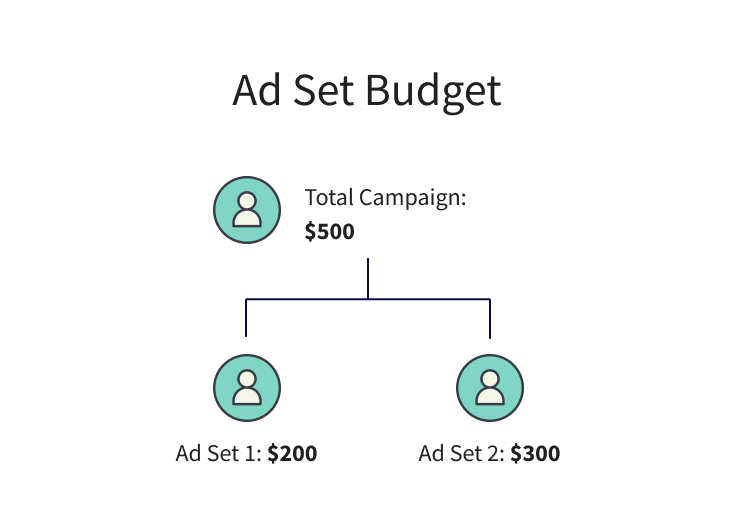
Advantages of ad set budget:
- additional control over delivery within certain ad sets
- suitable for ad campaigns that have just several ad sets
- can be useful when it comes to mixed optimization goals and bid strategies
- best suited for large differences in audience size between ad sets
Drawbacks of ad set budget:
- requires monitoring and optimizing bid strategies
Now that you've decided how your money will be distributed amongst ad sets, you must select how each ad set will spend its budget over time. Building upon this, let’s dig into the budget duration, which is presented by the daily budget and lifetime budget.
Daily budgets vs Lifetime budgets
For both campaign budgets and ad set budgets, you may specify whether your campaign or ad set budget applies to each day, or to the entire lifetime of the campaign or ad set.
Daily budgets: The average amount you'd like to spend on an ad set or campaign each day. This option suits perfectly if you’re willing to spend roughly the same amount each day to obtain consistent daily results.
How it works: You set an average amount of money that you’re willing to spend each day over the course of a week according to your ad schedule and budget. Facebook will do its hardest to meet it.
Advantages of daily budget:
- easier to control budgets
- can be used for ongoing campaigns
- suitable for setting up always-on or evergreen campaigns
- a great solution for weekly, monthly, or quarterly budgets that change from time to time
Drawbacks of daily budget:
- Facebook allows itself some flexibility, thus it can shift the numbers around a little and spend up to 25% over your daily budget on specific days when better opportunities are available
Lifetime budgets: Basically, it is the maximum amount of money you will spend at the end of the ad running period. You can set a lifetime budget if you have a start and end date to your campaign. The amount of money spent day-to-day will vary.
How it works: You select an end date and a total spend amount. Facebook’s algorithm picks the best times to show ads on your behalf. On days when performance is high, Facebook will spend more than the average daily budget.
Advantages of lifetime budget:
- requires less management,
- easy to see the total cost for a campaign,
- ad scheduling available.
Drawbacks of lifetime budget:
- daily spend can fluctuate leading to difficulties in predicting outcomes,
- adjusting the budget and changing the end date will more likely impact how Facebook prioritizes budget.
These budget selections might help you maximize your hard-earned marketing budget depending on the type of ad campaign you're running. Now that you know about the different budget types, you can start looking at how to determine your campaign’s ideal budget.
How to set up the right budget for Facebook ads
Here you’ll find five tips on how to reduce the cost of Facebook ads.
Set the right campaign parameters
Consider your ad goals and content, as well as where you’re at in the sales funnel. From there, you may come up with a plan for distributing your ad money among campaigns or ad sets.
When you’re creating a new ad campaign, start by determining your marketing objective. Once you’ve settled on a campaign objective, you can begin to figure out what you need to spend to get there.
Campaign goals are frequently divided into three categories:
- Awareness: Getting others to notice your services, product, or brand.
- Consideration: Getting your target audience to think of you as a solution to their issues.
- Conversion: Converting your audience into paying customers.
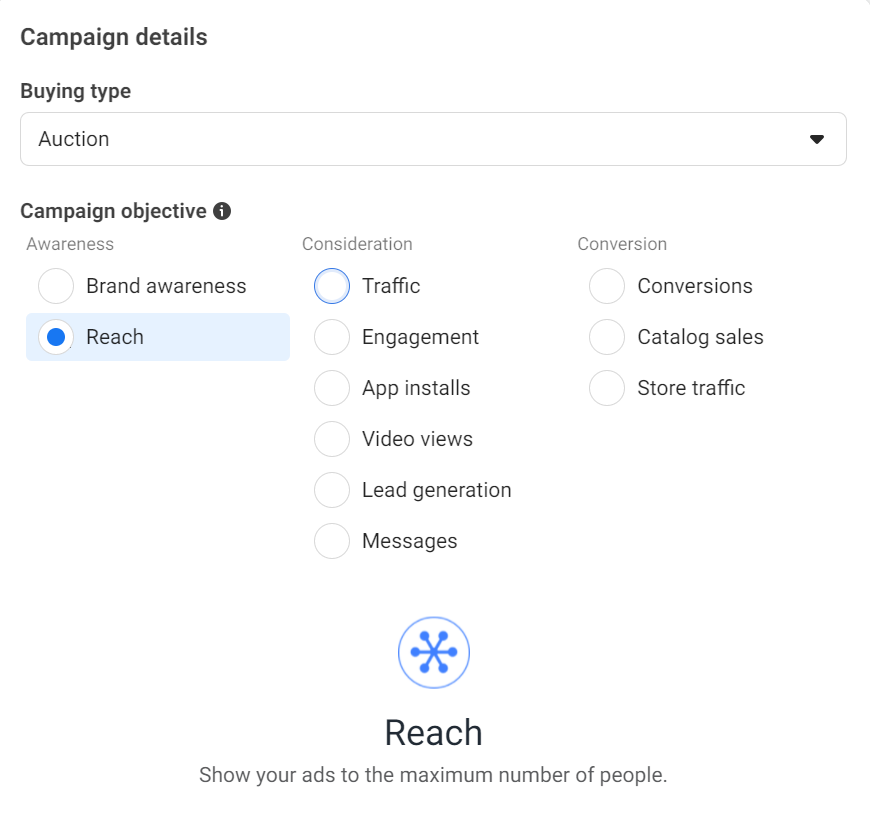
What to pay attention to
Facebook advertising costs can vary by a lot depending on the industry, your ad placement, target audience, and multiple other factors. Here are some of them to consider:
1. Industry
Your ad costs are heavily influenced by your business specialization. Facebook ads offering insurance or banking will be far more expensive than those promoting clothing.
2. Bidding strategy
One of the most important factors in determining your ad prices is your bidding strategy. You must pick whether to use automatic bidding and opt-in for the lowest cost or to personally manage your ad costs.
3. Timing
During different times of the day, the same Facebook ad might cost more or less. Also, during seasonal events, when everyone is competing for the attention of customers, ads will cost significantly more.
4. Audience
If you're attempting to target the same demographics as a lot of other marketers at the same time, your Facebook ad costs will go up. Bare in mind that you won't be competing with just your niche's brands. You'll also face competition from companies that sell different items but appeal to the same demographic as you.
5. Ad placement
The more competitive your ad placement is, the more your ads will cost you.
6. Ad objective
Your ads will cost you more if you choose the wrong objective for your ad, such as choosing a lead generation objective when all you want to do is raise brand awareness.
7. Relevance score
The costs of your ads will be higher if they are not relatable to your target audience.You'll spend less on advertising if you design high-quality ads that provide value to your potential consumers and meet their expectations.
Understand how much it might cost
You won't have to mechanically calculate any metrics since Facebook Ads Manager will do it on your behalf. However, if you're curious about how the calculations are performed, here are the key metrics to assist you to understand how Facebook advertising costs are calculated and what you’re paying for.
- Cost per result (CPR)
The average cost of achieving the desired result depending on your campaign's objective (i.e., view counts for a video views objective). It is usually used to evaluate the results of several ad campaigns and scale the most effective Facebook advertising to increase sales.
To calculate our cost per result, divide the total amount spent during the selected period by the number of results.
- Cost per 1000 impressions (CPM)
CPM indicates how much it cost to obtain 1,000 impressions.
It works best for increasing brand awareness. Divide the money spent on your ad campaign by the number of impressions and multiply the result by 1,000 to get your CPM.
- Cost per click (CPC)
CPC indicates how much one click costs.
It’s best used when you want people to click on your ads and visit your store. Divide the total money spent on your ad by the number of link clicks to get your CPC.
- Click-through rate (CTR)
The rate at which people click on your Facebook ad. A high CTR indicates that the ad is performing successfully.
- Conversion rate
How often your ad leads to a conversion when it gets clicked on. A poor conversion rate might signal a mismatch between the ad and the landing page, so double-check that your ad is selling precisely what you're offering (and that your website is ready to convert visitors).
Start small, track your metrics, scale
Facebook campaigns are hardly ever likely to succeed straight away. Time is needed for Facebook and for you to collect data and then optimize ads.
So, while you're testing, start with a little budget for Facebook ads that you can afford to lose. Based on how effectively the ad is doing, monitor and optimize your campaign.
Conclusion
Although it may appear difficult at first, managing Facebook ad budgets becomes simpler with practice. The greatest thing is that once you understand how they work, you'll be able to make the most of every Facebook ad campaign you run. The steps outlined above will assist you in determining the appropriate Facebook advertising budget for your company. It's essential to consider your numbers and goals, as well as market data and your own personal conversion data, and then decide how you'll use that money for running your ads.

